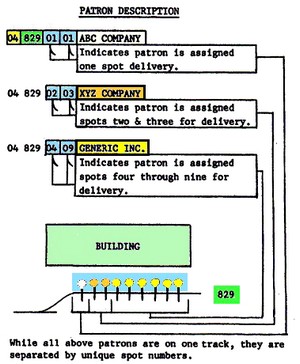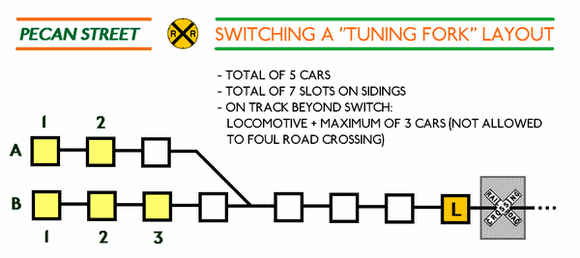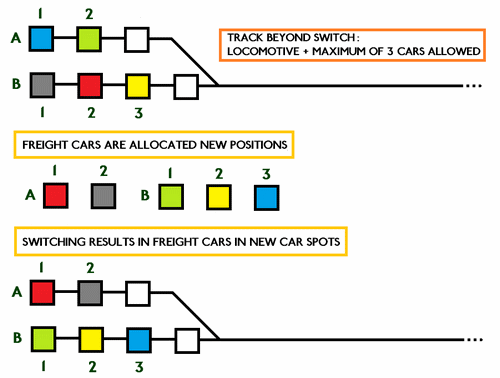
|
| |
|
| |
|
| |
| The trackplan of a "tuning fork"
layout tends to be deceiving. The bare bones
simplicity of having nothing but an approach
spur, a switch, and two tracks beyond that, seems
to suggest very limited (if any) operational
interest. But that's because we tend to look at
such a simple trackplan the wrong way.
The operational "spice" of switching
a "tuning fork" layout is not generated
by the trackplan, but rather by the way the spurs
are switched - by using so-called car spots.
|
| |
|
| Car spotting takes place where
one track (such as a single spur running
alongside a warehouse) either serves multiple
customers in that structure or has different
areas for loading and unloading.
Different
US railroads use(d) differing terminology for
this car spot designation system; the acronym
SPINS is an abbreviation for Southern Pacific
Industry Numbering System - it originated on
the SP but was also used by e.g. BN. CLIC (Car
Location Identity Codes) was a Santa Fe term
for the same thing, as was ZTS (Zone, Track,
Spot) on Conrail.
The example shown here (taken
from a 1987 Conrail ZTS for its New England
Division) explains it all quite well. If a
freight car is to be set out at 04-829-07, then
the ZTS map will tell any crew that its
destination is car spot 07 on track 829 in Zone
04, and that the customer in question is the
Generic Inc.
It is easy to see how requiring freight cars
to be placed in specific spots can add not only
additional realism to a switching layout but also
beef up the challenge of operating it
considerably.
And just like that, a single industrial spur
isn't that simple to switch anymore.
|
|
 |
|
| |
| Pecan Street has five such car spots, two
directly in front of the warehouse and three on the
adjacent spur. The standard "tuning fork"
formula is expanded by the single spot at the cold
storage (C). |
| |
 |
|
Applying the core idea of the
Conrail ZTS system, Pecan Street
provides the option to switch these car spots
with as many (or as few) cars and according to
whatever scheme comes to mind and hits your
operational fancy - you could use switching
orders, draw card orders, or even just make up
switching moves as you go along. |
|
| |
| In the real world and under normal circumstances, the
two tracks serving the warehouse would hardly ever see a
big congregation of boxcars, and this too can easily be
replicated. |
| |
 |
|
Using car spots to determine
where rolling stock is picked up or dropped off,
the complexity of switching a "tuning
fork" will vary according to the number of
cars in use. Possibly just for the fun of running
a favourite locomotive and a few colourful
boxcars, this can provide a relaxing fifteen or
so minutes of easy-going operation. |
|
| |
|
| |
SWITCHING PUZZLE MODE
|
| |
| In order to operate a tuning fork layout such as
Pecan Street as a switching puzzle, certain constraints
must be introduced as to how many items of rolling stock
can go where. The number of car spots on Pecan Street
reflects the capacity limits of the two sidings; two
directly in front of the warehouse and three on the
adjacent spur, with a "free spot" on both
sidings.
In addition, switching puzzles also call for a
capacity restriction to the spur leading up to the switch
for those two tracks, i.e. the headshunt track - an
artifical complication of the situation. In real life,
the train crew might well be able to pull out all the
boxcars that would possibly fit on both sidings in one
move; by not allowing this, the puzzle aspect is
introduced.
|
| |
| After a few trial runs on paper,
I found that restricting the capacity of the
approach track to a maximum of 3 boxcars plus the
locomotive provided the necessary wiggleroom to
produce solvable puzzle set-ups; a lower capacity
(2 cars plus loco) can result in situations where
a boxcar gets stuck at the end of the longer spur
because it cannot be pulled. All of this
results in the "tuning fork switching
puzzle" formula "2(+1) / 3(+1) /
3+L".
|
|
 |
|
| |
| The capacity boundary of the approaching track on
Pecan Street is marked by a road crossing, implying some
sort of a rule in place here that the crossing may not be
blocked for switching moves. The actual lengths of
track needed for this switching puzzle are, of course,
directly related to the rolling stock used. Since I
wanted 50' boxcars and second generation four-axle
road-switchers (e.g. an EMD GP38), this resulted in the
extended length of Pecan Street; using 40' boxcars and a
short locomotive (e.g. a GE 44t switcher) will reduce the
overall length of the layout considerably.
|
| |
 |
|
At the start of the swicthing
puzzle, five items of rolling stock occupy all of
the five car spots. Each item of rolling stock
is then allocated a new car spot (in some cases,
this will coincidentally be the same spot it is
sitting in at the outset).
The goal of the puzzle (and thus the task of
the operator) is to switch the rolling stock to
the newly designated spots.
The car spots will most likely be decided by
an element of chance (e.g. by drawing car cards
or rolling a dice), but the rolling stock could
also be switched around according to requirements
set by the operator.
Things can be made more challenging by
introducing either an element of trying to keep
the number of moves to a minimum or by setting a
time limit.
|
|
| |
| Most of the time, this will prove to be a not too
challenging switching puzzle, although certain set-ups
can require some advance planning of the "pull out,
shove in" switching moves. In that respect, it is
not unlike an Inglenook
Sidings layout, albeit with a significantly reduced
complexity. |
| |

Overall view of the
warehouse tracks with a typical set-up on Pecan Street in
switching puzzle mode
|
| |
| Cars can be identified for spotting in many ways,
ranging from creating elaborate cards for every car
(which can be shuffled and then state which car needs to
go where) to simply using cars so that only one colour is
present and then just drawing siple slips of paper
stating the colour selected (e.g. "yellow car to
spot B3"). Even though it is unlikely that a
tuning fork switching puzzle will keep you entertained
for hours on end, it does provide the opportunity of
having short but pleasant interludes of operation on a
layout that does not take up a lot of space, is easy to
set up and store away, and can be built in a reasonable
amount of time and on a modest (or even minimal) budget.
|
| |
| |
 |
| |
| |

Text and
pictures are (c) 2022-2025 Adrian Wymann.
|
| |
page created 12 March 2022
last updated 31 August 2023
|
|
| |








